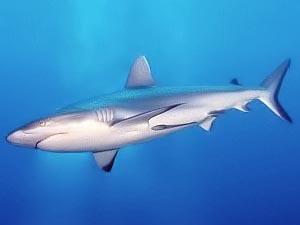
Back تعاكس الظلال Arabic Contraombreig Catalan Protistín Czech Konterschattierung German Kontraŭlumo Esperanto Contracoloración Spanish ضدسایه Persian Ombre inversée French הצללת נגד HE カウンターシェーディング Japanese


a) in position b) inverted.
Countershading, or Thayer's law, is a method of camouflage in which an animal's coloration is darker on the top or upper side and lighter on the underside of the body.[1] This pattern is found in many species of mammals, reptiles, birds, fish, and insects, both in predators and in prey.
When light falls from above on a uniformly coloured three-dimensional object such as a sphere, it makes the upper side appear lighter and the underside darker, grading from one to the other. This pattern of light and shade makes the object appear solid, and therefore easier to detect. The classical form of countershading, discovered in 1909 by the artist Abbott Handerson Thayer, works by counterbalancing the effects of self-shadowing, again typically with grading from dark to light. In theory this could be useful for military camouflage, but in practice it has rarely been applied, despite the best efforts of Thayer and, later, in the Second World War, of the zoologist Hugh Cott.
The precise function of various patterns of animal coloration that have been called countershading has been debated by zoologists such as Hannah Rowland (2009), with the suggestion that there may be multiple functions including flattening and background matching when viewed from the side; background matching when viewed from above or below, implying separate colour schemes for the top and bottom surfaces; outline obliteration from above; and a variety of other largely untested non-camouflage theories. A related mechanism, counter-illumination, adds the creation of light by bioluminescence or lamps to match the actual brightness of a background. Counter-illumination camouflage is common in marine organisms such as squid. It has been studied up to the prototype stage for military use in ships and aircraft, but it too has rarely or never been used in warfare.
The reverse of countershading, with the belly pigmented darker than the back, enhances contrast and so makes animals more conspicuous. It is found in animals that can defend themselves, such as skunks. The pattern is used both in startle or deimatic displays and as a signal to warn off experienced predators. However, animals that habitually live upside-down but lack strong defences, such as the Nile catfish and the Luna moth caterpillar, have upside-down countershading for camouflage.
- ^ Argo, Emily (21 April 2017). "Countershading". Fishionary. American Fisheries Society. Retrieved 17 December 2022.
© MMXXIII Rich X Search. We shall prevail. All rights reserved. Rich X Search